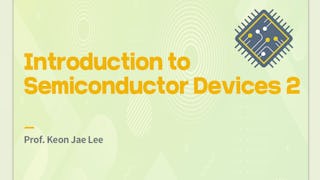PLEASE NOTE: This version of the course has been formed from an earlier version, which was actively run by the instructor and his teaching assistants. Some of what is mentioned in the video lectures and the accompanying material regarding logistics, book availability and method of grading may no longer be relevant to the present version. Neither the instructor nor the original teaching assistants are running this version of the course. There will be no certificate offered for this course.

Gain next-level skills with Coursera Plus for $199 (regularly $399). Save now.

(149 reviews)
Skills you'll gain
Details to know
6 assignments
See how employees at top companies are mastering in-demand skills

There are 12 modules in this course
Welcome to the “MOS Transistors” course! We are very excited to be able to offer this course, and are looking forward to working with you.
What's included
2 videos1 reading
What's included
10 videos1 assignment
What's included
9 videos1 assignment
This is the first module we are dealing with the complete transistor; much of this material, as well as next module's material, will form the core of what we will be covering in the rest of the course. We hope you will spend extra time studying to make sure you understand this material in depth. The total viewing time in each of these two modules is shorter, which should help.
What's included
5 videos
This material concludes the lectures on the long-channel transistor in DC operation. As mentioned earlier, these lectures will form the core on which many of our subsequent discussions will be based.
What's included
5 videos1 assignment
In this module we are dealing with phenomena that occur when the transistor dimensions are made small; this is important knowledge to have when one is dealing with modern devices.
What's included
8 videos1 assignment
This module we will finish with small dimension effects, and then talk about models for circuit simulation (the circuit designers among you are probably already using such models). We discuss what it takes to make a good model for circuit simulation (among other things: a lot of caution and care, and about 20,000 lines of code!), and how you can spot possible problems with such models. Although models for circuit simulation include capabilities we have not yet discussed, such as charge modeling, we think you know enough about models at this point to be able to follow this general discussion (which is out of sequence – it’s from Chap. 10 in the book, where you can find much more on the subject).
What's included
9 videos
In this module there is a significant departure from what we have done up to this point: we will allow the terminal voltages of the transistor to vary with time. We will determine the resulting terminal currents, which will now include a “charging” component. We will do this both for moderate and for very high “speeds”. The transient response of circuits involves similar calculations, only done by computer for an ensemble of transistors and other devices.
What's included
8 videos
The material for this module deals with small-signal modeling, and constitutes an important part of the description of MOS transistor behavior. It relates small changes in terminal voltages to the resulting small changes in currents. Small-signal modeling is key to analog circuit design, but not only; it is also used in high-performance digital circuit design (e.g., in designing memory sense amplifiers).
What's included
6 videos
This material concludes our discussion of small-signal modeling; it shows how we can model the transistor at frequencies at which the simple model we derived last week is not valid. Such modeling is important in high-frequency applications, e.g. transceiver design.
What's included
6 videos1 reading1 assignment
The exam is open book, open notes, open videos. It covers the material of the first nine weeks of videos in the course. You are NOT allowed to discuss the exam, directly or indirectly, with anyone. Anybody found in violation of this rule will be removed from the course. You should, of course, feel free to report technical issues with the exam and its submission.
What's included
1 assignment
Although your knowledge of this material will not be tested in the final exam, we urge you to go through it, as it deals with important topics, namely noise, ion implantation and substrate nonuniformity, and statistical variability; these topics will help complete your understanding of MOS transistors.
What's included
10 videos
Instructor

Offered by
Explore more from Electrical Engineering
 Status: Preview
Status: PreviewKorea Advanced Institute of Science and Technology(KAIST)
 Status: Free Trial
Status: Free Trial Status: Free Trial
Status: Free TrialUniversity of Colorado Boulder
 Status: Preview
Status: PreviewKorea Advanced Institute of Science and Technology(KAIST)
Why people choose Coursera for their career




Learner reviews
149 reviews
- 5 stars
73.82%
- 4 stars
15.43%
- 3 stars
8.05%
- 2 stars
2.01%
- 1 star
0.67%
Showing 3 of 149
Reviewed on Jul 17, 2017
Extremely useful and well planned course! Must for every analog circuit designer...
Reviewed on Oct 29, 2016
This is the best lecture avaliable on internet. The whole lecture are well designed and and explained. Sir please provide lectures on analog circuit design concept.
Reviewed on Apr 11, 2017
I come from electrical engineering background. I found the material in the course very insightful and easy to follow.
Frequently asked questions
To access the course materials, assignments and to earn a Certificate, you will need to purchase the Certificate experience when you enroll in a course. You can try a Free Trial instead, or apply for Financial Aid. The course may offer 'Full Course, No Certificate' instead. This option lets you see all course materials, submit required assessments, and get a final grade. This also means that you will not be able to purchase a Certificate experience.
More questions
Financial aid available,





